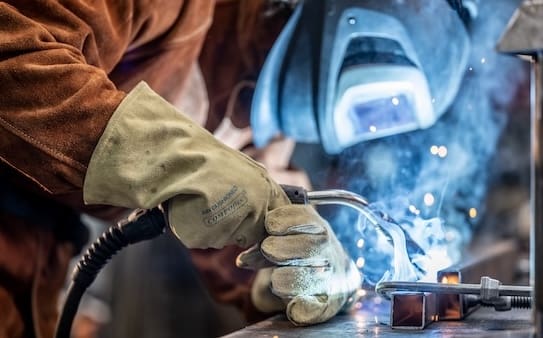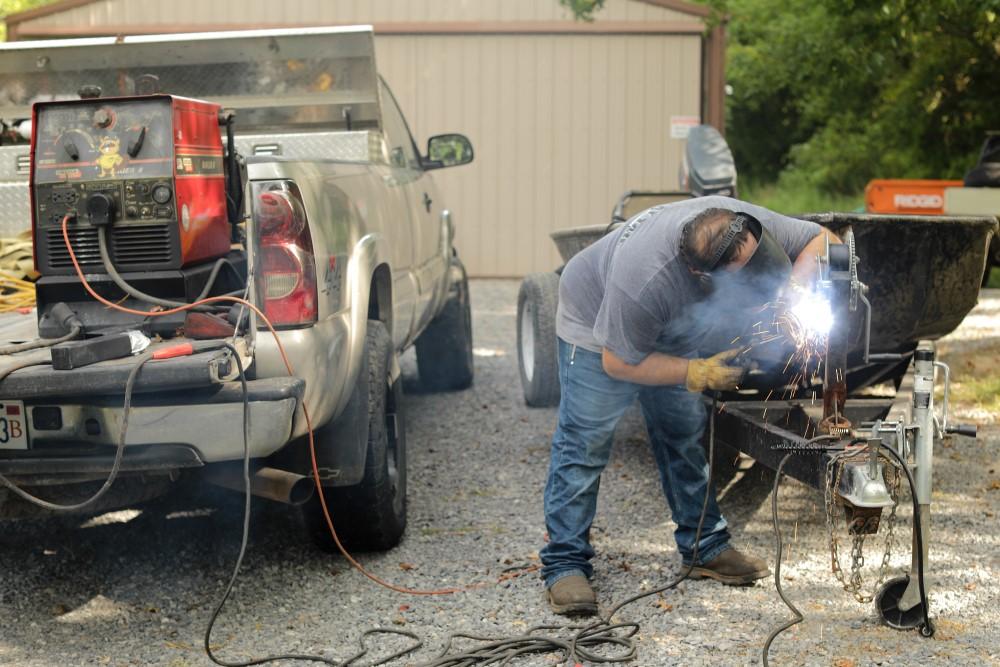Usual Welding Repair Service Issues and How to Address Them Effectively
Welding repair work usually encounter a range of issues that can threaten the honesty of the end product. Usual problems consist of inadequate infiltration, porosity, and misalignment, to name a few. Each defect presents special obstacles that require specific techniques for resolution. Understanding these concerns is necessary for welders aiming to boost their skills and results. This conversation will certainly discover these typical welding repair work problems and effective approaches to resolve them.
Inadequate Penetration
Inadequate penetration happens when the weld steel stops working to totally fuse with the base product, causing weak joints and potential architectural failings. This problem commonly originates from insufficient warm input, wrong electrode angle, or inappropriate welding rate. Welders might come across insufficient infiltration due to a mistake of the essential specifications for a specific product thickness or type. Furthermore, contamination on the base product's surface area can impede reliable bonding, aggravating the issue. To resolve poor penetration, welders must guarantee suitable settings on their devices and maintain a tidy job surface area. Regular inspection of welds is advised to recognize any kind of shortages early, enabling timely improvements and the avoidance of compromised structural stability in bonded settings up.
Porosity
Porosity is a typical flaw in bonded joints that shows up as little gas bubbles caught within the weld metal. This flaw can endanger the honesty of the weld, bring about reduced strength and potential failure under anxiety. Welding. Porosity generally occurs from contamination, dampness, or inappropriate welding strategies, which permit gases to escape into the molten weld pool. To attend to porosity, welders should guarantee correct surface area prep work, keep a clean working setting, and use suitable welding criteria. In addition, choosing the appropriate filler material and shielding gas can mitigate gas entrapment. Normal evaluation and screening of welds can assist identify porosity early, ensuring prompt restorative activities are taken, consequently maintaining the high quality and reliability of the bonded structure
Misalignment
Imbalance in welding can develop from different elements, including inappropriate setup and thermal development. Understanding the root causes is important for reliable resolution. Numerous correction techniques are readily available to straighten elements and assure architectural honesty.
Sources of Misalignment
Welding misalignment typically stems from a selection of underlying concerns that can jeopardize structural honesty. One key reason is inappropriate fit-up of parts before welding, which can bring about voids and irregular surface areas. Variations in thermal development during the welding process can additionally cause distortion, particularly if the products being joined have various coefficients of expansion. Additionally, insufficient clamping and fixturing might fall short to hold components firmly in location, bring about motion during welding. Badly kept equipment, consisting of welding machines and devices, may present incongruities in the weld grain, additional contributing to misalignment. Ultimately, driver mistake, stemming from insufficient training or experience, can also play a substantial duty in producing misaligned welds.
Correction Techniques Available
Dealing with misalignment effectively requires a mix of restorative techniques tailored to the details problems at hand. One common technique is the use of jigs or fixtures to hold components in the proper setting during welding, making sure consistent alignment. Furthermore, pre-heating the materials can help in reducing distortion and boost fit-up. For substantial imbalance, mechanical adjustment methods, such as using hydraulic jacks or clamps, can be employed to deal with the position prior to welding. Post-weld heat therapy may additionally be necessary to alleviate stress and anxieties brought on by misalignment. Finally, mindful examination and change throughout the setup phase can stop imbalance concerns from coming to be substantial troubles, promoting a smoother welding process and boosting general architectural honesty.
Distortion
Distortion is a common difficulty in welding that can develop from various elements, including uneven cooling and heating. Understanding the reasons for distortion is important for carrying out efficient avoidance techniques. Addressing this issue not only improves structural stability however also enhances the overall top quality of the weld.
Causes of Distortion
When subjected to the extreme heat of welding, materials frequently go through changes that can cause distortion. This sensation mainly occurs from thermal growth and tightening throughout the welding process. As the weld area warms up, the product broadens; upon cooling, it acquires, which can create inner stresses. Additionally, uneven heating across a work surface can exacerbate these tensions, leading to warping or flexing. The kind of product also next page plays a substantial role; metals with varying thermal conductivity and coefficients of growth may react differently, leading to unpredictable distortions. Furthermore, inadequate joint layout and poor fixturing can add to misalignment throughout welding, increasing the possibility of distortion. Comprehending these reasons is essential for effective welding repair service and avoidance techniques.
Prevention Techniques
Effective prevention strategies for distortion throughout welding concentrate on controlling warmth input and guaranteeing correct joint layout. Maintaining a regular heat input assists to lessen thermal expansion and contraction, which can bring about pop over to these guys distortion. Using techniques such as preheating the work surface can additionally decrease the temperature gradient, promoting uniform home heating. Furthermore, choosing proper joint styles, such as T-joints or lap joints, can boost stability and reduce stress concentrations. Executing appropriate fixturing to secure the workpieces in position additionally help in preserving placement throughout the welding procedure. Lastly, staggered welding sequences can distribute warmth much more evenly, protecting against localized distortion. By applying these approaches, welders can substantially decrease the chance of distortion and improve the total top quality of their welds.
Fracturing
Splitting is an usual problem encountered in welding repair services, usually arising from different elements such as improper air conditioning prices, product selection, or insufficient joint prep work. The event of fractures can considerably jeopardize the integrity of the weld, bring about possible failures throughout operation. To resolve this concern, welders need to first evaluate the origin, making certain that products are compatible and appropriately chosen for the certain application. In addition, regulating the cooling rate throughout the welding process is vital; quick air conditioning can cause stress and anxiety and result in splitting. Correct joint style and preparation also add to lessening the danger. Carrying out these techniques can boost weld high quality and resilience, ultimately decreasing the possibility of cracking in completed weldments.

Incomplete Blend
A considerable problem in welding repair services is insufficient fusion, which occurs when the weld metal does not properly bond with the base product or previous weld passes - Montana Mobile Welding and Repair Belgrade. This flaw can bring about weak points in the joint, possibly jeopardizing the stability of the welded structure. Elements contributing to incomplete blend include not enough heat input, improper welding strategy, and contamination of the surfaces being joined. To address this problem properly, welders ought to assure look at these guys correct pre-weld cleansing and surface area prep work, as well as adjust their welding specifications to achieve appropriate infiltration and combination. Routine assessment during the welding process can additionally help determine insufficient fusion early, permitting timely rehabilitative steps to enhance the total top quality of the weld
Overheating
While welding fixings can enhance structural integrity, overheating offers a significant obstacle that can lead to material deterioration. Excessive warm throughout welding can change the mechanical properties of steels, leading to reduced stamina, raised brittleness, and bending. This sensation is especially essential in high-stress applications where structural integrity is critical. Identifying overheating can involve aesthetic examinations for staining or distortion, along with checking temperature throughout the welding procedure. To reduce the risks associated with getting too hot, welders need to employ proper methods, such as regulating warm input, changing travel speed, and making use of appropriate filler products. Additionally, applying pre- and post-weld heat treatments can aid recover product buildings and enhance the overall high quality of the repair work, ensuring lasting efficiency and safety and security.
Frequently Asked Concerns
What Are the Common Signs of a Welding Issue?

Just How Can I Test My Welds for Quality?
To evaluate welds for high quality, one can use aesthetic inspections, ultrasonic testing, and radiographic techniques. Each method ensures structural honesty, identifies flaws, and validates adherence to defined requirements, ultimately enhancing the reliability of the bonded joints.
What Safety and security Preventative Measures Should I Take While Welding?
When welding, one need to focus on safety and security by using ideal personal protective tools, making certain appropriate air flow, securing flammable products away, keeping a tidy work area, and recognizing surroundings to stop accidents and injuries.
Can I Repair a Weld Without Redesigning the Entire Joint?
Repairing a weld without redoing the entire joint is feasible, depending upon the damage (Fabrication). Methods such as grinding, adding filler material, or utilizing a welding process can successfully resolve specific problems while preserving the bordering framework
What Tools Are Crucial for Efficient Welding Fixes?
Essential devices for effective welding repairs consist of a welding equipment, wire brush, grinder, protective gear, clamps, and filler materials. Each tool plays an essential role in ensuring top quality and security during the repair service procedure. Porosity commonly occurs from contamination, wetness, or improper welding techniques, which permit gases to escape right into the liquified weld swimming pool. Badly kept devices, consisting of welding equipments and devices, might present disparities in the weld grain, more contributing to imbalance. When subjected to the intense heat of welding, products commonly undertake changes that can lead to distortion. Splitting is an usual issue encountered in welding repair work, often resulting from various factors such as inappropriate air conditioning rates, product option, or poor joint prep work. A significant problem in welding repairs is incomplete combination, which happens when the weld steel does not effectively bond with the base product or previous weld passes.